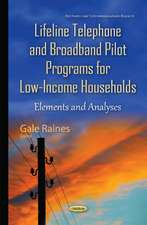Metropolitan Area Networks: Telecommunication Networks and Computer Systems
Autor Marco Pellegrini, Enrico Gregori, Luciano Lenzinien Limba Engleză Paperback – 23 iul 2012
Preț: 647.73 lei
Preț vechi: 762.04 lei
-15% Nou
Puncte Express: 972
Preț estimativ în valută:
123.98€ • 134.72$ • 104.21£
123.98€ • 134.72$ • 104.21£
Carte tipărită la comandă
Livrare economică 21 aprilie-05 mai
Preluare comenzi: 021 569.72.76
Specificații
ISBN-13: 9781447112327
ISBN-10: 1447112326
Pagini: 448
Ilustrații: XII, 433 p.
Dimensiuni: 155 x 235 x 24 mm
Greutate: 0.62 kg
Ediția:Softcover reprint of the original 1st ed. 1997
Editura: SPRINGER LONDON
Colecția Springer
Seria Telecommunication Networks and Computer Systems
Locul publicării:London, United Kingdom
ISBN-10: 1447112326
Pagini: 448
Ilustrații: XII, 433 p.
Dimensiuni: 155 x 235 x 24 mm
Greutate: 0.62 kg
Ediția:Softcover reprint of the original 1st ed. 1997
Editura: SPRINGER LONDON
Colecția Springer
Seria Telecommunication Networks and Computer Systems
Locul publicării:London, United Kingdom
Public țintă
Professional/practitionerCuprins
1 Introduction.- 1.1 Capacity.- 1.2 From LANs to MANs.- 1.3 Fairness.- 1.4 User-oriented Performance Figures.- 1.5 Modeling of a MAN Environment.- 1.6 Outline of Contents.- 2 Stochastic Processes for Modeling Metropolitan Area Networks: Basic Results.- 2.1 Queueing Models for MAN Modeling.- 2.2 System Properties.- 2.3 Some Results on Renewal and Regenerative Processes.- 2.4 Work Conservation Laws.- 2.5 Stochastic Decomposition Laws.- 2.6 Pseudo-conservation Laws.- 3 Methods for the Analysis of Node-In-Isolation Models.- 3.1 M/G/l Systems.- 3.2 M/G/l Systems with Vacation.- 3.3 M/G/l-type Models.- 3.4 Application of Node-in-isolation Models: Worst-case Analysis.- 4 Methods for the Analysis of Network-Wide Models: Polling Models.- 4.1 From Pseudo-conservation Laws to Waiting Time Analysis.- 4.2 Numerical Methods.- 4.3 For Further Study.- 5 Fiber-Distributed Data Interface (FDDI).- 5.1 Introduction.- 5.2 FDDI Layers and Services.- 5.3 MAC Protocol.- 5.4 FDDI MAC Protocol Capacity.- 5.5 FDDI Cycle Properties.- 5.6 Remarks on the IEEE 802.4 Token Bus Protocol.- 5.7 Current Use of FDDI.- 6 FDDI Models.- 6.1 Introduction.- 6.2 Network-wide Models.- 6.3 Station-in-isolation Models.- 6.3.1 M/G/l with Vacation and Exhaustive Limited with Limit Variation Service Discipline (Model 5).- 6.4 Model 4: Details of the Computation.- 7 Distributed Queue Dual Bus (DQDB).- 7.1 Functional Architecture of a Node.- 7.2 Connectionless Data Service.- 7.3 DQDB Performance and Fairness.- 7.4 The Bandwidth Balancing Mechanism.- 7.5 DQDB MAC Protocol Capacity.- 7.6 Current Use of DQDB.- 8 DQDB Models.- 8.1 Introduction.- 8.2 Network-wide Models.- 8.3 Node-in-isolation Models.- 9 Evolution Towards Gigabit Rates.- 9.1 Shared Medium Gigabit Networks.- 9.2 ATM-based Gigabit Networks.- Acronyms.- Glossary of Notation.


















